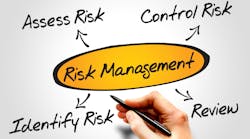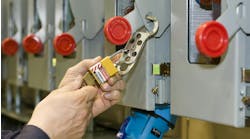NFPA 70E identifies the three elements of a risk assessment procedure as [110.5(H)(1)]:
- Identify hazards.
- Assess risks.
- Implement risk control according to the hierarchy of risk control methods.
The first Informational Note following this says the risk assessment procedure could identify when a second person could be required, and the training and equipment needed by that person.
The second Informational Note following this refers you to Informative Annex F. This annex sheds light on the principles and how to implement them. The tables and figures bring detail and clarity to the somewhat abbreviated text of 110.5(H).
Figure F.1 provides a closed-loop flow chart of the steps used to assess risk. First, you establish the context (e.g., what is the job, where is the job, etc.). Then you engage in three risk assessment steps (identify the hazards, analyze the risk, assess the risk); these steps are expounded on in Annex F. Then you implement risk control. Finally, you monitor and review how the risk controls are working and go back to the beginning of the process (establishing context) and start again if you need to.
In Annex F, you find a visually clear representation of what is meant by the hierarchy of risk control methods in the form of Table E.3. The first thing you want to try is eliminating the hazard. Table E.3 gives an example of how this might be done in a particular instance. There are six steps in the hierarchy, with the last one being PPE. You can often think of PPE as “when all else fails,” in the sense that the other methods don’t totally eliminate the risk.
Other times, you can think of PPE as “when all else fails” in the sense that PPE is a backup control method in case of an abnormal condition with one of the higher-up measures and its failure to protect as intended.
However, if we flip back to 110.5(H) and drop down to 110.5(H)(3), we see these six methods presented in a list format. Informational Note 2 tells you to go to the table we just discussed, but Informational Note 1 gives you a greater understanding of why this list is the way it is. The main concept here is to try to eliminate or reduce the risk at its source. That’s in contrast to using PPE to help you cope with the risk (or hazard).
When the risk is designed out of the system (or out of the job), the need to rely on human awareness, human judgment, and the absence of human error is greatly reduced if not totally eliminated.
Risk assessment always begins with identifying the hazards. They are not always obvious, so take the time to “dry run” the job and look for them. Once you know what they are, you need to determine the likelihood and severity of each. None of this does any good unless you take that third step, which is to implement risk control.




